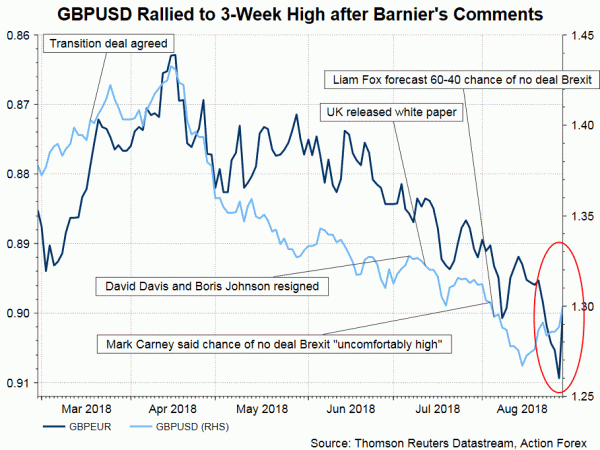The market is thrilled by comments from Michel Barnier, EU chief negotiator on Brexit, who noted that the EU is “prepared to offer Britain a partnership such as there never has been with any other third country”. We do not see any breakthrough from those comments, just as we find nothing new in media reports days ago, suggesting the so-called Brexit deadline could be postponed to mid-November from October.
What does “No Deal” Mean?
Talks of “no deal” have intensified over the past several weeks. For instance, UK Trade Secretary Liam Fox suggested earlier this month that he sees a “60-40” chance of a “no deal” Brexit while BOE governor Mark Carney noted that such chance is “uncomfortably high”. Last week, the Department for Exiting the European Union (DexEU) has started releasing technical notices for “preparedness” for no deal. These gestures have caused great misunderstanding to the market. It is generally believed that if the two counterparts fail to make a deal by October (or November), then the UK, by March 2019, would leave the single market without a trade agreement and fully expose to EU’s tariffs applied to general trading partners under WTO rules.
In fact, this is not the case. Broadly speaking, Brexit negotiations contain two most important parts: “Withdrawal Agreement” and the “Future Framework” before March 2019, and comprehensive negotiations on trade relations during the transition period. The October/ November deadline refers to the former only. In UK government’s notice on preparations for a ‘no deal’ scenario, it stated that a “no deal” scenario is one “where the UK leaves the EU and becomes a third country at 11pm GMT on 29 March 2019 without a Withdrawal Agreement and framework for a future relationship in place between the UK and the EU”. It added that, in a “no deal” scenario, there would be “no agreement to apply any of the elements of the Withdrawal Agreement described above”.
UK’s Bundling Strategy
We are not too pessimistic to believe that the above “no deal” scenario would materialise. The “Withdrawal Agreement” includes 3 issues: the financial settlement, citizens’ rights and, and the status of the border between Northern Ireland and the Republic of Ireland. According to Barnier around 80% of the questions here has been resolved. The final 20%, mainly concerning Irish border, is undoubtedly the most difficult part. While admitting that a long-term solution to this issue is extremely challenging, we believe both the UK and the EU are keen on finding a temporary fix, sticking to the “backstop” solution agreed in June during the transition period.
There is no requirement that the “Future Framework” has to contain details trade terms and rules. Under the terms of Article 50(2) TEU, the “Withdrawal Agreement must take account of the framework for the future relationship between Britain and the UK”. In this regard, the UK has published a detailed white paper (about 100 pages), trying to cover all aspects of the future relationship, while the EU has been intentionally brief with its 6-page document. We find the implications of the divergent attitude of the two parties as follows: Detailed discussion and conclusion of future trade relations is not a prerequisite for ratification of the Withdrawal Agreement and the Future Framework. EU aims at fulfilling the minimum requirement of European Council’s guideline on Article 50 negotiation: providing “overall understanding of the framework for the future relationship”. On the other hand, the UK attempts to tie the payment of the financial settlement and/ or Irish border with a satisfactory agreement on future trade relations.
We believe it is likely that a deal – for parliamentary ratification (UK and EU) on “Withdrawal Agreement” and the “Future Framework”- would be reached by year-end. This would pave the way for the next phase – the 21-month transition period starting March 29, 2019. This is also where comprehensive negotiation on future trade relations begins. We believe that negotiation during the transition period is the real challenge and a no (trade) deal scenario cannot be ruled. Yet, the recent volatility of British pound is front-loaded, mainly driven by misunderstanding of the real meaning of “no deal”.















